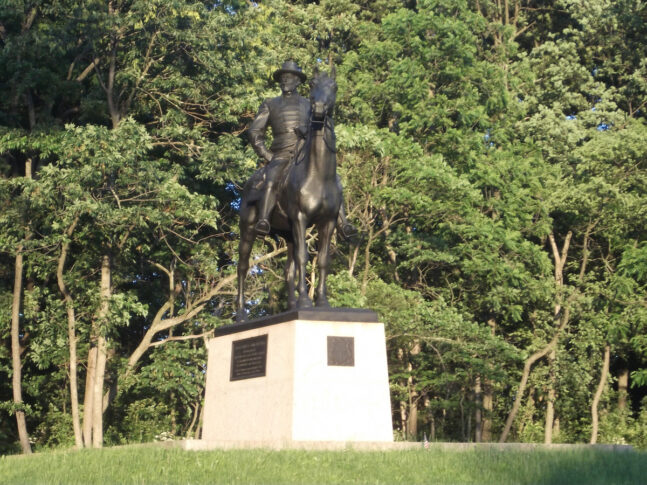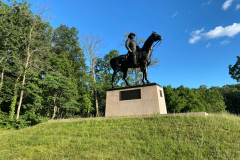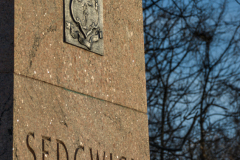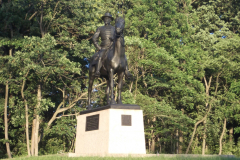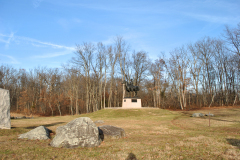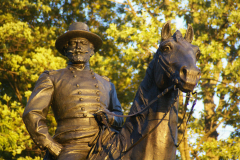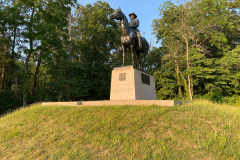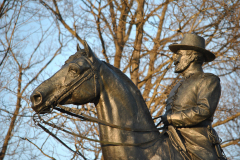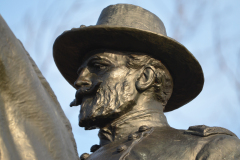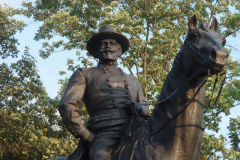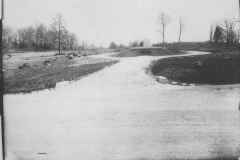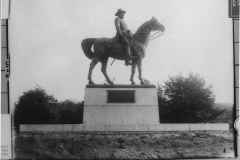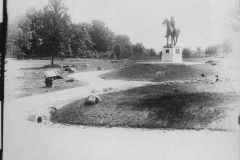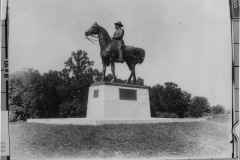Dedicated: June 19, 1913.
Location: Located on the east side of Sedgwick Avenue north of the Wheatfield Road. It is installed near the location of Sedgwick’s headquarters during the battle.
Description: An equestrian portrait of General Sedgwick and his mount, Handsome Joe, soon after their arrival on the battlefield during the afternoon of July 2, 1863. The general is shown looking over the battlefield toward the Wheatfield and Sherfy Peach Orchard. The general wears his hat and carries his sword on his left side. The sculpture is mounted on a rectangular base if Stony Creek granite adorned with bronze plaques. This sculpture of John Sedgwick, commander of the Union VI Corps, is one of six bronze equestrian statues in Gettysburg. The Sedgwick monument committee was begun in May 1907 with a $25,000 state appropriation for the placement of a monument to “Uncle John” Sedgwick. The artist’s model for the monument was approved in Nov. 1910. The horse is modeled after one of the general’s war mounts, Handsome Joe. The pedestal is inscribed with “Sedgwick” and a state seal on the west face. Overall height is twenty-one foot.
National Park Service List of Classified Monuments Number: MN112.
Sculptor: Henry Kirke Brown
About Major General John Sedgwick
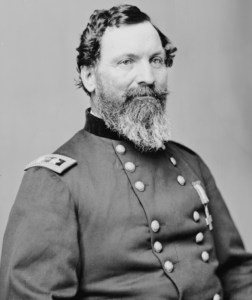 Born in Cornwall, Connecticut on September 13, 1813, Sedgwick was known to his men as “Uncle John.” He taught for two years before entering West Point, graduating in 1837 and commissioning into the artillery. He received two brevets in the Mexican War and later transferred to the cavalry service.
Born in Cornwall, Connecticut on September 13, 1813, Sedgwick was known to his men as “Uncle John.” He taught for two years before entering West Point, graduating in 1837 and commissioning into the artillery. He received two brevets in the Mexican War and later transferred to the cavalry service.
Sedgwick’s Civil War career began as a brigade commander during the Peninsula Campaign. He was wounded at Glendale and promoted to major general. At Antietam, he assaulted the West Woods as part of Sumner’s blundering attack; he was wounded three times and was out of action until Fredericksburg. During the Chancellorsville Campaign, he fought at Salem Church in command of the VI Corps.
Sedgwick’s corps was in reserve at Gettysburg. Because he was a vocal admirer of General McClellan, he was almost reassigned away from the VI Corps but was retained by Meade. On May 9, 1864, at Spotsylvania, Sedgwick was on the front lines, admonishing his men who were dodging sharpshooter bullets. His last words were, “Why are you dodging like this? They couldn’t hit an elephant at this distance.” He was shot through the face and bled out. Sedgwick was the highest-ranking general officer in the US Volunteer service to be killed in the war, outranking Reynolds and McPherson.
Sedgwick’s death was met by universal sorrow by both sides; even General Lee expressed his condolences. Sedgwick was buried near his home in Cornwall Hollow, Connecticut. In addition to his equestrian monument at Gettysburg, he has a statue at West Point, a monument in Cornwall Hollow, a granite marker where he fell at Spotsylvania, and several counties are named in his honor.
Other Monuments: Equestrian | Headquarters
